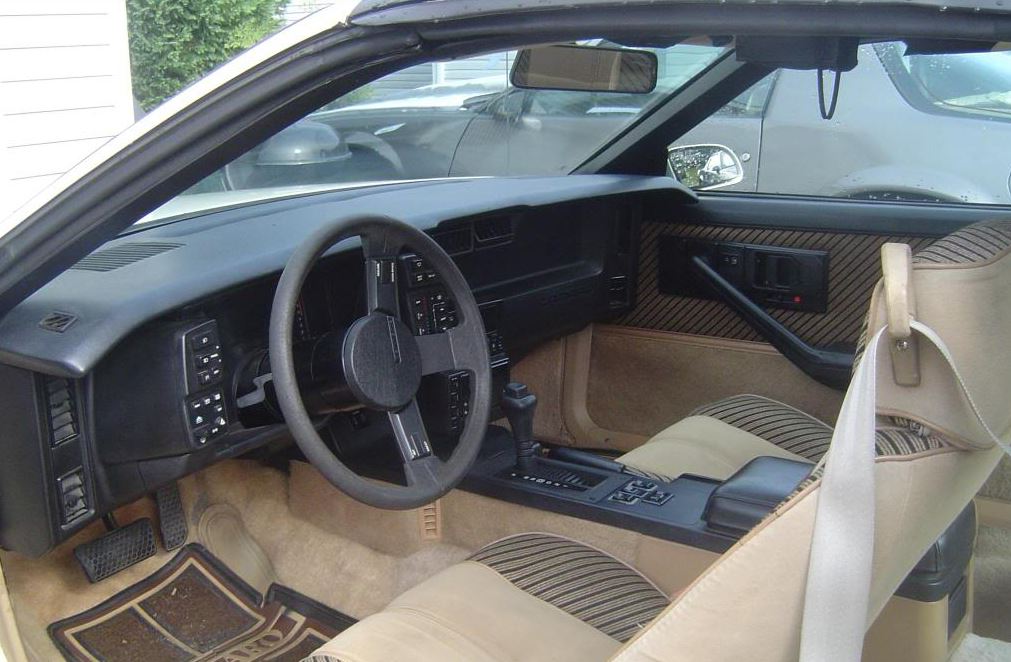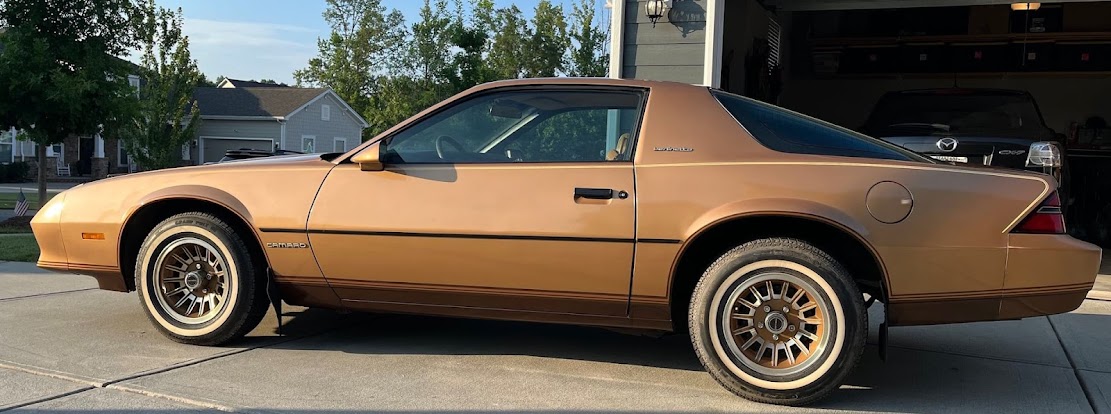1996 F355 Berlinetta
1987 Ferrari 328 GTB Berlinetta
There are a couple examples of the Ferrari Berlinetta, and of course Ferrari brought that word to the auto industry where GM/Chevrolet copied it, and tried to add some interest to boring 1979 through 1986 mid grade Camaros (less than Z28 and IROC Z).
Those really didn't have much going for them. Nothing really competed in that price point either, so...
I had a high school classmate with a 1982 Camaro, that he wanted to sell... in 1988 or 89, for 3200 I think it was. I got a ride in it, and did instantly fall for it.... all that 80s hard plastic boring flat dash was so representative of the early MTV era.
From https://www.thetruthaboutcars.com/2020/11/rare-rides-the-1984-chevrolet-camaro-berlinetta-a-sports-car-for-luxurious-people/ I get this info on "Berlinetta"
A luxury specification, its base engine was a 2.8-liter V6, though wealthier people opted for the 5.0 instead.
Exterior features found only on Berlinetta included the gold Berlinetta badges, headlamp insets painted in a contrast color to the body, and a unique finned alloy wheel design with gold tone and Berlinetta center caps.
Gold effects continued at the rear, with a glistening horizontal trim bar across the lamp assembly.Luxury Camaro customers would have to move on from Camaro after 1986, as GM saw fit to replace Berlinetta with LT for 1987.
The site https://www.thirdgen.org/forums/history-originality/620119-what-exactly-berlinetta.html says:
The Berlinetta was a premium luxury Camaro from 1982 - 1986 in the 3rd gen years. It did not have ground effects, so it would look like the Sport Coupe. It would normally come well optioned and could easily cost more than a Z28 of the same year. It also would be trimmed in gold on the exterior.
82-83 the Berlinetta basically was a Sport Coupe with tacky gold Camaro & Berlinetta emblems, gold stripes on the tail lights, different front turn signals as the turn signal switch is on the dash, not the column, a softer suspension, and gold aluminum 14" wheels.
84-86 Added the digital dash cluster, which used a completely unique dash shell, pedestal stereo, etc. Everything else remained about the same.
At it's most basic, it was a gold emblem package. It was aimed at female buyers, the most difficult demographic for car makers to appeal to. Women, generally, just don't care an iota for cars. They like horses, men like HORSEPOWER! as I've often heard.
If you knock off all the stupid emblems, and gold trim, you've got a Sport Coupe with a luxury suspension.
1982 comparison
For 1984, though, someone decided that the Berlinetta should also be the vanguard of the Camaro’s high-tech aspirations, and the Berlinetta got its own special dashboard complete with digital vacuum-fluorescent displays (VFD), numerical for the speedo and a little cool bar graph setup for the tachometer.
This sort of high-tech look and feel was clearly a marketing goal, as seen in commercials like this, where a high-tech woman with the high-tech job of what looks like suspension bridge design is sick of her simulations blinking the word PROBLEM over and over, so she takes to her appropriately high-tech Berlinetta to drive those pesky problems away
skip the first 40 seconds







Most things sound better in Italian; An Italian reading a paragraph from a chainsaw repair manual sounds poetic to English-speaking ears. Of the cars, the terms used in Italian are usually more evocative than those in English (although some actually have French roots): Consider quattroporte, berlina, berlinetta, spyder (and spider), Auto da corsa, barchetta, superleggera etc. Many of the terms used for cars date from the days of horse drawn coaches & buggies (spider, cabriolet, shooting brake et al).
ReplyDeleteso true. I have one Italian aunt, one French Canadian, and one Thai. Plus, yes, I've went into the history of the terminology of wagons, carriages, cars, etc somewhere in the archives, probably back around 2010.
DeleteBerlinetta was something that had been bugging me, and today, I hit back at that nagging motivation to get a post up about it.
One of these days, maybe I'll do Barchetta.
Damn, now I'm hungry for brushetta!
I never understood some terms though, shooting brake. Spider. Neither, in the English language, mean what they describe on a car. Well, neither does Boot.
Thanks for commenting!
I don't recognize your "CoSC" have you commented before, and how long have you been reading my blog, roughly?
I recall reading some time ago in a long lost automotive magazine that Berlinetta simply meant " with a roof"
ReplyDeleteI came across your blog over a year ago and have previously commented although I don't know under what handle; I sometimes use different devices. It's such an entertaining blog because you cast the net so wide which I guess "cool things with wheels" permits.
ReplyDeleteThe origin of the use of spider lies in the horse & buggy era when a spider phaeton was a lightweight horse-drawn carriage intended for short-distance journeys and the design was intended to impress so there was often on protection from the elements beyond perhaps something to shade ladies from the sun. Unlike some true “convertible” or “cabriolet” carriages, there were no side windows and the spider name was gained from the “spider”, a small single seat or bench for the use of a groom or footman, the name based on the spindly supports which called to mind an arachnid’s legs. Quite where this style of coachwork was first seen isn’t known but they were certainly in use on both sides of the Atlantic in the 1860s and it’s not impossible the invention was both simultaneous and independent although there are sources which insist it was first seen in the ante-bellum US. The appearance in Italy of cars called "spyders" was just product differentiation and some manufactures have used both spellings.
The industry never settled on an agreed definition of the shooting brake body style but from the mid-twentieth century it’s been used usually to describe a two-door coupé with estate-car coachwork added. In recent years, what are (somewhat misleadingly) labelled shooting brakes have tended to be based on fast sports cars rather than the large chassis familiar in the 1930s when the intent was to offer the rich a large, comfortable car for outings like shooting parties, the enlarged rear compartment easily accessible and sufficiently capacious handily to accommodate guns, picnic baskets and (on a good day) a few brace of grouse on the trip home. For reasons related to economics and engineering, the creation of shooting brakes declined in the post-war years and the release of the Range-Rover in 1970 rendered the style extinct except for the rare one-off creation for those who still hankered for conspicuous exclusivity. The sporty breed of coupés with estate coachwork which many (Volvo, Reliant, BMW, Ferrari, Lancia et al) have offered in recent decades are really not shooting brakes, the design instead intended to enlarge luggage space beyond the “toothbrush & bikini” capacity of some sports cars. However, nobody seems to have thought of a better term.
The origin of the name lies in the shooting brake which was a large horse-drawn cart suitable for use by shooting parties. The “brake” in the name is derived from the popularity among shooting parties of the heavy-framed carts used when “breaking-in” spirited horses although, etymologists have pointed out the Dutch word brik (cart or carriage) but any link is speculative. In the UK, the term brake became so identified with large horse-drawn carts than it came to be applied widely, extended to wagons generally, whether used for shooting parties or not. In France, an estate car (station wagon) was called a break, the French (somewhat unusually) following the example in English, the original form having been break de chasse (hunting break).
Thanks! I'm glad you find it entertaining! After the first decade, I got a bit looser with my "things with wheels" rule, and included roads, bridges, driveways... the things that are required for vehicles. Oh, and news that affects public safety as a driver.
DeleteAnyway, after 30 or 40 thousand posts, there were fewer things coming up on the internet that were simply incredible vehicles, and I have a thing about not reposting stuff, so, in order to stay with new to me things, I relaxed a little on the rule about the wheels. There was a beautiful time around 2007-2011 where the automotive enthusiasts were more flush with cash, and lots more was being made, like the old tractors getting upgraded to racing specs by whiskey companies, and the Blastolene Brothers made new humongous vehicles. The Top Gear show still had Clarkson, May, Hammond and the Stig
Oddly enough, a similar golden era was occurring at Comic Con, and corporations were flush with money and brought bonkers amounts of entertainment to Hall H.
Anyway, it's a bit less exciting in the auto zone now, and less incredible things are coming up to post about. So, I've went on with a bit more history, news, etc.
Wow! And you're an etymologist! Well, thank you for getting to the origin of the Spider and Shooting Brake! I was perplexed how the English language already had an arachnid, and the word spider was commonly known to everyone, even the illiterate, but still somehow the term was used on vehicles, with zero obvious connection to the arachnid!
Shooting brake... that is something else... heavy cart for breaking in horses, used for shooting parties.
Huh! Thank you!
Since you are relatively new to the blog, I recommend looking through the best years, 2013-2016. Really good stuff back there in the archives!